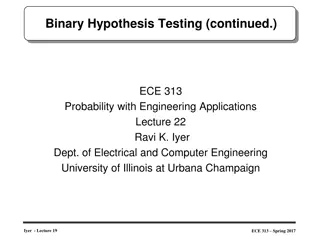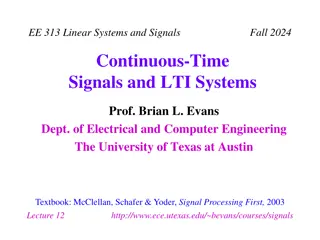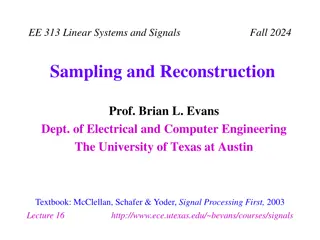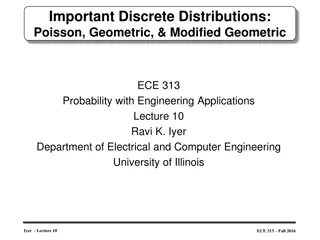
Production Functions and Productivity Analysis
Explore the concept of production functions, factors of production, stages of production, and tools like Average Physical Product and Marginal Physical Product for analyzing productivity. Learn how inputs map to outputs and the impact of changing variables in production processes.
Download Presentation

Please find below an Image/Link to download the presentation.
The content on the website is provided AS IS for your information and personal use only. It may not be sold, licensed, or shared on other websites without obtaining consent from the author. If you encounter any issues during the download, it is possible that the publisher has removed the file from their server.
You are allowed to download the files provided on this website for personal or commercial use, subject to the condition that they are used lawfully. All files are the property of their respective owners.
The content on the website is provided AS IS for your information and personal use only. It may not be sold, licensed, or shared on other websites without obtaining consent from the author.
E N D
Presentation Transcript
Technology Beattie, Taylor, and Watts Sections: 2.1-2.2, 5.1-5.2b 1
Agenda The Production Function with One Input Understand APP and MPP Diminishing Marginal Returns and the Stages of Production The Production Function with Two Input Isoquants 2
Agenda Cont. Marginal Rate of Technical Substitution Returns to Scale Production Possibility Frontier Marginal Rate of Product Transformation 3
Production Function A production function maps a set of inputs into a set of outputs. The production function tells you how to achieve the highest level of outputs given a certain set of inputs. Inputs to the production function are also called the factors of production. The general production function can be represented as y = f(x1, x2, , xn). 4
Production Function Cont. The general production function can be represented as y = f(x1, x2, , xn). Where y is the output produced and is a positive number. Where xi is the quantity of input i for i = 1, 2, , n and each is a positive number. 5
Production Function with One Input In many situations, we want to examine what happens to output when we only change one input. This is equivalent to investigating the general production function previously given holding all but one of the variables constant. 6
Production Function with One Input Cont. Mathematically we can represent the production function with one input as the following: y = f(x) = f(x1) = f(x1|x2,x3, ,xn) Suppose y = f(x1, x2, x3) = x1*x2*x3 Suppose that x2 = 3 and x3 = 4, which are fixed inputs, then y = f(x) = f(x1) = f(x1|3,4) = 12x1 =12x 7
Example of Production Function y = f(x) = -x3 + 60x2 Production Function 35000 30000 25000 20000 y 15000 10000 5000 0 0 10 20 30 40 50 60 8
APP and MPP There are two major tools for examining a production function: Average Physical Product (APP) Marginal Physical Product (MPP) 9
APP The average physical product tells you the average amount of output you are getting for an input. We define APP as output (y) divided by input (x). APP = y/x = f(x)/x 10
Example of Finding APP Assume you have the following production function: y = f(x) = -x3 + 60x2 + 3 2 60 y x x = = APP x x = + 2 60 x APP x x = ( 60 ) APP x 11
Example of Finding Maximum APP To find the maximum APP, you take the derivative of APP and solve for the x that gives you zero. From the previous example: APP = -x2 + 60x dAPP APP ( ) d = = + 2 max 60 x x dx dx dAPP = + = 2 60 0 x dx = 30 x 12
MPP The marginal physical product tells you what effect a change of the input will do to the output. In essence, it is the change in the output divided by the change in the input. MPP is defined as: dy MPP = = ( ' x ) f dx 13
Example of Finding MPP Assume you have the following production function: y = f(x) = -x3 + 60x2 ( ) dy d = = + 3 2 60 MPP x x dx dx = + x 2 3 120 MPP x x = 3 ( 40 ) MPP x 14
Interpreting MPP When MPP > 0, then the production function is said to have positive returns to the use of the input. This occurs on the convex and the beginning of the concave portion of the production function. In the previous example, this implies that MPP > 0 when input is less than 40 (x<40). 15
Interpreting MPP Cont. When MPP = 0, then we know that the production function is at a maximum. Setting MPP = 0 is just the first order condition to find the maximum of the production function. In the example above, MPP = 0 when the input was at 40. 16
Interpreting MPP Cont. When MPP < 0, then the production function is said to have decreasing returns to the use of the input. This occurs on the concave portion of the production function. In the previous example, this implies that MPP < 0 when input is greater than 40 (x>40). 17
Example of APP and MPP y = f(x) = -x3 + 60x2 APP and MPP 1500 1000 500 0 APP MPP 0 10 20 30 40 50 60 -500 -1000 -1500 -2000 18
Law of Diminishing Marginal Returns (LDMR) The Law of Diminishing Marginal Returns states that as you add successive units of an input while holding all other inputs constant, then the marginal physical product must eventually decrease. This is equivalent to saying that the derivative of MPP is negative. 19
Finding Where LDMR Exists Suppose y = f(x) = -x3 + 60x2 To find where the LDMR exists is equivalent to finding what input levels give a second order condition that is negative. dy = = + 2 3 120 MPP x x dx 2 dMPP d y = = + = ( 6 6 120 20 ) x x 2 dx dx To find dMPP where LDMR exists set the above term negative ( 6 0 20 ) 0 ( 20 ) 0 x x dx 20 x 20
Relationship of APP and MPP When MPP > APP, then APP is rising When MPP = APP, then APP is at a maximum When MPP < APP, then APP is declining 21
Relationship of APP and MPP Cont. ( ) f x = APP x ( ) dAPP d f x = ( ' dx dx x ) 2 ( ) dAPP xf x f x = dx x 2 ( ' ) ( ) dAPP xf x f x = = when 0 0 dx x dAPP = = ( ) 2 when 0 ( ' ) ( ) 0 * xf x f x x dx dAPP = = ( ) when 0 ( ' ) ( ) xf x f x dx ( ) dAPP f x = = ( ) when 0 ( ' ) f x dx x dAPP = = when 0 MPP APP dx 22
Stages of Production Stage I of production is where the MPP is above the APP, i.e., it starts where the input level is 0 and goes all the way up to the input level where MPP=APP. To find the transition point from stage I to Stage II you need to set the APP function equal to the MPP function and solve for x. 23
Stages of Production Cont. Stage II of production is where MPP is less than APP but greater than zero, i.e., it starts at the input level where MPP=APP and ends at the input level where MPP=0. To find the transition point from Stage II to Stage III, you want to set MPP = 0 and solve for x. Stage III is where the MPP<0, i.e., it starts at the input level where MPP=0. 24
Finding the Transition From Stage I to Stage II Suppose y = f(x) = -x3 + 60x2 dy = = + 2 3 120 MPP x x dx + x 2 3 120 y x x = = = + 2 60 APP x x x APP = To APP find the transitio MPP n point set MPP and solve for x = + = + 2 2 60 3 120 x x x x x = 2 2 60 0 x x = 2 x ( 30 ) 0 x = = 0 or 30 x 25
Finding the Transition From Stage II to Stage III Suppose y = f(x) = -x3 + 60x2 dy = = + 2 3 120 MPP x x dx 0 = To MPP find the transitio n point set MPP and solve for x = x 0 + x = 2 3 120 0 x x = 3 = ( 40 x ) 0 x = 0 or 40 26
Production Function with Two Inputs While one input production functions provide much intuitive information about production, there are times when we want to examine what is the relationship of output to two inputs. This is equivalent to investigating the general production function holding all but two of the variables constant. 27
Production Function with Two Inputs Cont. Mathematically we can represent the production function with one input as the following: y = f(x1,x2) = f(x1,x2|x3, ,xn) 28
Example of a Production Function with Two Variables: y=f(x1,x2)=-x13+25x12-x23+25x22 5000.00 4500.00 4000.00 4500.00-5000.00 4000.00-4500.00 3500.00 3500.00-4000.00 3000.00 3000.00-3500.00 2500.00-3000.00 2500.00 2000.00-2500.00 2000.00 1500.00-2000.00 1000.00-1500.00 1500.00 500.00-1000.00 1000.00 24 0.00-500.00 18 500.00 12 0.00 6 0 2 4 6 8 10 12 14 16 0 18 20 22 24 29
Example 2 of a Production Function with Two Variables: y=f(x1,x2)=8x11/4x23/4 80 70 60 70-80 50 60-70 50-60 40 40-50 30 30-40 20-30 20 10-20 10 0-10 0 10 8 10 9 8 6 7 6 4 5 4 3 2 2 1 0 0 30
Three Important Concepts for Examining Production Function with Two Inputs There are three important concepts to understand with a production function with two or more inputs. Marginal Physical Product (MPP) Isoquant Marginal Rate Of Technical Substitution (MRTS) 31
MPP for Two Input Production Function MPP for a production function with multiple inputs can be viewed much like MPP for a production function with one input. The only difference is that the MPP for the multiple input production function must be calculated while holding all other inputs constant, i.e., instead of taking the derivative of the function, you take the partial derivative. 32
MPP for Two Input Production Function Cont. Hence, with two inputs, you need to calculate the MPP for both inputs. MPP for input xi is defined mathematically as the following: ( x MPP i , ) f x x = = 1 x 2 f x i i ( , ) f x x = = 1 x 2 MPP f x x 1 1 1 , ( ) f x x = = 1 x 2 MPP f x x 2 2 2 33
Example of Calculating MPP Suppose y = f(x1,x2) = -x13+25x12-x23+25x22 = = + + 3 1 ) 2 1 3 2 2 2 ( , ) 25 25 y f x x x x x x 1 2 ( , f x x = = + 2 1 3 50 1 x 2 MPP x x 1 x 1 1 , ( ) f x x = = + 2 2 3 50 1 x 2 MPP x x 2 x 2 2 34
Example 2 of Calculating MPP Suppose y = f(x1,x2) = 8x11/4 x23/4 1 3 = = ( , ) 8 y f x x x x 4 4 2 1 2 1 3 3 3 3 3 3 ( , ) 1 f x x x x 4 2 4 = = = = = 8 2 2 2 1 x 2 2 MPP x x x x 4 4 2 4 4 2 1 1 x 3 4 x 1 1 1 x 4 1 1 1 1 1 1 1 ( , ) 3 f x x x x 4 4 = = = = = 8 6 6 6 1 x 2 1 1 MPP x x x x 4 4 4 4 1 2 1 2 x 1 4 x 2 2 2 x 4 2 35
Note on MPP for Multiple Inputs When the MPP for a particular input is zero, you have found a relative extrema point for the production function. In general, the MPP w.r.t. input 1 does not have to equal MPP w.r.t. input 2. 36
The Isoquant An isoquant is the set of inputs that give you the same level of output. To find the isoquant, you need to set the dependent variable y equal to some number and examine all the combinations of inputs that give you that level of output. An isoquant map shows you all the isoquants for a given set of inputs. 37
Example of An Isoquant Map: y = -x12+24x1-x22+26x2 24 21 300.00-350.00 250.00-300.00 200.00-250.00 150.00-200.00 100.00-150.00 50.00-100.00 0.00-50.00 -50.00-0.00 18 15 12 9 6 3 24 0 0 4 8 12 16 20 38
Example 2 of An Isoquant Map: y = 8x11/4 x23/4 10 9 8 7 60-80 40-60 20-40 0-20 6 5 4 3 2 1 100 0 2 4 6 8 39
Finding the Set of Inputs for a General Output Given y = -x12+24x1-x22+26x2 Suppose y = -x12+24x1-x22+26x2 We can solve the above equation for x2 in terms of y and x1. x x x x y + + 1 1 2 2 26, b 1, a define we If = + + 2 1 2 2 24 26 1 2 = 2 2 26 24 0 x x x = x y = = + 2 1 and c 24 x x y 1 2 4 b b 2 ac = x 2 a + 2 2 1 26 ( 26 ) 1 ( 4 )( 24 ) x x y = 1 x 2 ) 1 ( 2 + 2 1 26 676 4 96 4 x 2 x y = 1 x 2 = + 2 1 x 13 169 24 x x y 2 1 40
Question From the previous example, does it make economic sense to have both the positive and negative sign in front of the radical? No, only one makes economic sense; but which one. You should expect that you will have an inverse relationship between x1 and x2. This implies that for this particular function, you would prefer to use the negative sign. 41
Finding the Set of Inputs for a General Output Given y = 8x11/4 x23/4 Suppose y = 8x11/4 x23/4 We can solve the above equation for x2 in terms of y and x1. 1 3 = = ( , ) 8 y f x x x x 4 4 2 1 2 1 3 y = x 4 2 1 8 x 4 1 3 / 4 y = x 2 / 1 1 3 16 x 42
Marginal Rate of Technical Substitution (MRTS) The Marginal Rate of Technical Substitution tells you the trade-off of one input for another that will leave you with the same level of output. In essence, it is the slope of the isoquant. 43
Finding the MRTS There are two methods you can find MRTS. The first method is to derive the isoquant from the production function and then calculate the slope of the isoquant. The second method is to derive the MPP for each input and then take the negative of the ratio of these MPP. 44
Equivalency Between Slope of the Isoquant and the Ratio of MPP s dx = = MRTS Slope of the isoquant 2 dx 1 dy = We know that MPP x dx i i dy MPP dx x = 1 1 dy MPP x 2 dx on the are we 2 Since isoquant t he change in y for each MPP is equal MPP dx x = = 2 MRTS 1 MPP dx x 1 2 45
Finding the MRTS Using the ratio of the MPPs Given y = -x12+24x1-x22+26x2 Suppose y = -x12+24x1-x22+26x2 = + + 2 1 2 2 24 x 26 y x x x x 1 2 y = = + 2 24 MPP x 1 x 1 1 y = = + 2 26 MPP x 2 x x 2 2 MPP + 2 24 x x = = 1 MRTS 1 + 2 26 MPP x 2 x 2 46
Finding the MRTS Using the Slope of the Isoquant Given y = -x12+24x1-x22+26x2 Suppose y = -x12+24x1-x22+26x2 From previously we found that the isoquant for the above function w as + 2 1 26 676 4 96 4 x x y = 1 x 2 2 ( 169 ) 1 = + 2 1 x 13 24 x x y 2 2 x 1 ( 169 ) 1 = + 2 1 13 24 2 x x y 2 1 x x 1 1 ( 169 ) ( 1 x 1 ) = + + 2 1 24 2 24 2 x x y x 2 1 1 x 2 1 ( ) + x 12 x = 2 1 ( 169 )2 1 x + 2 1 24 x x y 1 1 47
Finding the MRTS Using the Slope of the Isoquant Given y = -x12+24x1-x22+26x2 Cont. ( ( 24 y know we 1 x ) + x 12 x = 2 1 ) + 1 x + 2 1 169 = 24 x x y 1 2 1 + 2 2 2 26 x x x x x 1 2 ( ) + x 12 = 2 1 ( 169 ) 1 x + + + 2 1 2 1 2 2 24 24 26 x x x x x 1 2 1 1 2 ( ) + x 12 x = 2 1 ( 169 ) 1 x + + + 2 1 x 2 1 2 2 24 + 24 26 x x x x x x 1 2 1 1 2 ( ) x 12 = 2 1 ( 169 ) 1 x + 2 2 + 26 x x 1 2 2 ( ) ) ) x 12 x = 2 1 ( 1 x 2 + 13 + 1 x 2 2 x ( x 12 = 2 1 + x 13 x 1 2 48
Finding the MRTS Using the ratio of the MPPs Given y = Kx1 x2 Suppose y = Kx1 x2 = y Kx x 1 2 y = = 1 MPP Kx x 1 2 x x 1 1 y = = 1 MPP Kx x 1 2 x x 2 2 MPP 1 Kx x x = = 1 2 MRTS 1 1 MPP Kx x 1 2 x 2 + 1 1 1 1 2 x x x x x = = = 1 2 1 2 MRTS x 1 49
Finding the MRTS Using the Slope of the Isoquant Given y = Kx1 x2 Suppose y = Kx1 x2 1 2 y = y Kx x 2 = x 1 Kx 1 1 y y = = x x 2 1 1 Kx K 1 x x y = 2 x 1 x K 1 1 1 x y 1 = 2 x 1 x K 1 1 x y = 2 x 1 x K 1 50














